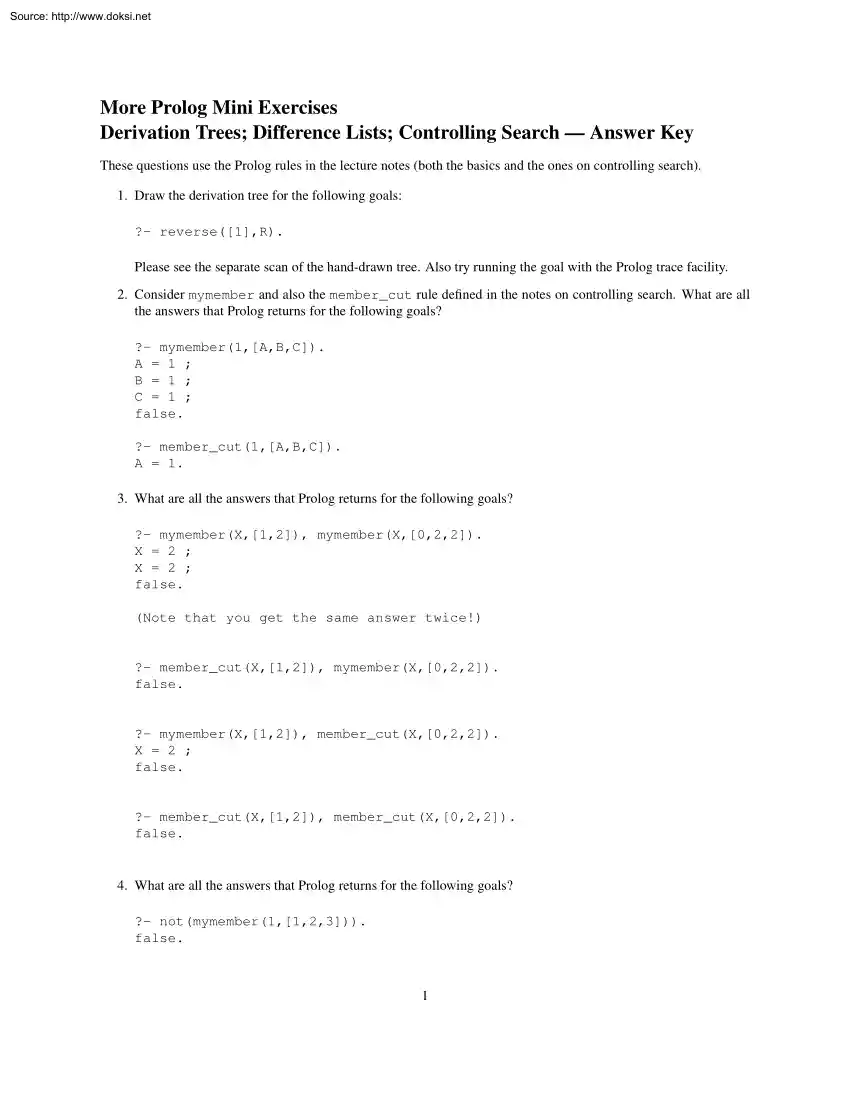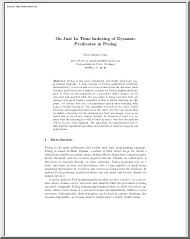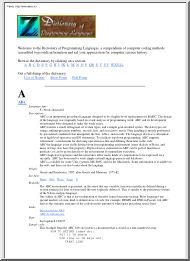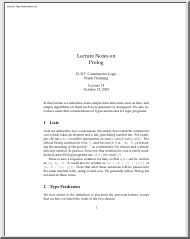A doksi online olvasásához kérlek jelentkezz be!

A doksi online olvasásához kérlek jelentkezz be!
Nincs még értékelés. Legyél Te az első!
Mit olvastak a többiek, ha ezzel végeztek?
Tartalmi kivonat
Source: http://www.doksinet More Prolog Mini Exercises Derivation Trees; Difference Lists; Controlling Search Answer Key These questions use the Prolog rules in the lecture notes (both the basics and the ones on controlling search). 1. Draw the derivation tree for the following goals: ?- reverse([1],R). Please see the separate scan of the hand-drawn tree. Also try running the goal with the Prolog trace facility 2. Consider mymember and also the member cut rule defined in the notes on controlling search What are all the answers that Prolog returns for the following goals? ?- mymember(1,[A,B,C]). A = 1 ; B = 1 ; C = 1 ; false. ?- member cut(1,[A,B,C]). A = 1. 3. What are all the answers that Prolog returns for the following goals? ?- mymember(X,[1,2]), mymember(X,[0,2,2]). X = 2 ; X = 2 ; false. (Note that you get the same answer twice!) ?- member cut(X,[1,2]), mymember(X,[0,2,2]). false. ?- mymember(X,[1,2]), member cut(X,[0,2,2]). X = 2 ; false. ?- member cut(X,[1,2]), member
cut(X,[0,2,2]). false. 4. What are all the answers that Prolog returns for the following goals? ?- not(mymember(1,[1,2,3])). false. 1 Source: http://www.doksinet ?- not(mymember(5,[1,2,3])). true. ?- not(mymember(X,[1,2,3])). false. ?- mymember(X,[1,2,3]), not(mymember(X,[1,2,4])). X = 3 ; false. ?- not(mymember(X,[1,2,4])), mymember(X,[1,2,3]). false. 5. Consider the standard version of append: append([],Ys,Ys). append([X|Xs],Ys,[X|Zs]) :- append(Xs,Ys,Zs). If you know that the first argument is ground (that is, fully instantiated, containing no variables), there is a more efficient version that you can write by including a cut. (a) Define such a version. append([],Ys,Ys) :- !. append([X|Xs],Ys,[X|Zs]) :- append(Xs,Ys,Zs). (b) Give an example of a query that has exactly the same behavior for both the standard version and the version with a cut. append([1,2],[3,4,5],X). (c) Give an example of a query that behaves differently for for the standard version and the version with a
cut. append(A,B,[1,2,3]). (d) What restrictions do we need on the inputs for the two versions to behave exactly the same? (Is it that the first argument is ground?) No, it’s a little more general: just that the first argument not be a variable or a list with a variable as the tail of the list. 6. Which of the following lists represent valid difference lists? For valid difference lists, what list do they represent? [1,2|T]T [1,2,3][] [1,2,3][1,2] [1,2,3|T][3|T] [1,2,3][1,2,3] -- valid, represented [1,2] -- valid, represents [1,2,3] -- not valid -- valid, represents [1,2] -- valid, represents [] 2 Source: http://www.doksinet 7. Write the list [squid,clam] as a difference list (in the most general possible way) Also draw a box-andarrow diagram of the first part of the difference list [squid,clam|T]T | | | | | | | o | ----|----->| o | T | | | | | | | | | | | | | squid clam Notice that this remains a valid difference list
representation of [squid,clam]no matter what we unify with T. For example, if we unify T with [octopus], we get this difference list: [squid,clam,octopus][octopus] which still represents [squid,clam]. [squid,clam|T]: Here’s the box-and-arrow representation of what happens to | | | | | | | | / | | o | ----|----->| o | ----|---> | o | / | | | | | | | | | | | | / | | | | | | | squid clam octopus 8. Using the clpr library, write a rule mymin such that if you call mymin(A,B,C), C will be the minimum of A and B. mymin(X,Y,X) :- {X<=Y}. mymin(X,Y,Y) :- {X>Y}. 9. Write a rule solve using the clpr library that solves the simultaneous equations 2x + 3y = 8 and x + y = 3 solve(X,Y) :- {2*X + 3Y=8, X+Y=3}. 10. Again using the clpr library, write a rule sum such that for sum(Xs,S), S is the sum of the numbers in the list Xs. You can assume the list consists only of numbers For example sum([],S) should
succeed with S=00, sum([3,4],S) should succeed with S=7.0, and sum([A,A],10) should succeed with A=50 sum([],0). sum([X|Xs],S) :- sum(Xs,S1), {X+S1=S}. 3
cut(X,[0,2,2]). false. 4. What are all the answers that Prolog returns for the following goals? ?- not(mymember(1,[1,2,3])). false. 1 Source: http://www.doksinet ?- not(mymember(5,[1,2,3])). true. ?- not(mymember(X,[1,2,3])). false. ?- mymember(X,[1,2,3]), not(mymember(X,[1,2,4])). X = 3 ; false. ?- not(mymember(X,[1,2,4])), mymember(X,[1,2,3]). false. 5. Consider the standard version of append: append([],Ys,Ys). append([X|Xs],Ys,[X|Zs]) :- append(Xs,Ys,Zs). If you know that the first argument is ground (that is, fully instantiated, containing no variables), there is a more efficient version that you can write by including a cut. (a) Define such a version. append([],Ys,Ys) :- !. append([X|Xs],Ys,[X|Zs]) :- append(Xs,Ys,Zs). (b) Give an example of a query that has exactly the same behavior for both the standard version and the version with a cut. append([1,2],[3,4,5],X). (c) Give an example of a query that behaves differently for for the standard version and the version with a
cut. append(A,B,[1,2,3]). (d) What restrictions do we need on the inputs for the two versions to behave exactly the same? (Is it that the first argument is ground?) No, it’s a little more general: just that the first argument not be a variable or a list with a variable as the tail of the list. 6. Which of the following lists represent valid difference lists? For valid difference lists, what list do they represent? [1,2|T]T [1,2,3][] [1,2,3][1,2] [1,2,3|T][3|T] [1,2,3][1,2,3] -- valid, represented [1,2] -- valid, represents [1,2,3] -- not valid -- valid, represents [1,2] -- valid, represents [] 2 Source: http://www.doksinet 7. Write the list [squid,clam] as a difference list (in the most general possible way) Also draw a box-andarrow diagram of the first part of the difference list [squid,clam|T]T | | | | | | | o | ----|----->| o | T | | | | | | | | | | | | | squid clam Notice that this remains a valid difference list
representation of [squid,clam]no matter what we unify with T. For example, if we unify T with [octopus], we get this difference list: [squid,clam,octopus][octopus] which still represents [squid,clam]. [squid,clam|T]: Here’s the box-and-arrow representation of what happens to | | | | | | | | / | | o | ----|----->| o | ----|---> | o | / | | | | | | | | | | | | / | | | | | | | squid clam octopus 8. Using the clpr library, write a rule mymin such that if you call mymin(A,B,C), C will be the minimum of A and B. mymin(X,Y,X) :- {X<=Y}. mymin(X,Y,Y) :- {X>Y}. 9. Write a rule solve using the clpr library that solves the simultaneous equations 2x + 3y = 8 and x + y = 3 solve(X,Y) :- {2*X + 3Y=8, X+Y=3}. 10. Again using the clpr library, write a rule sum such that for sum(Xs,S), S is the sum of the numbers in the list Xs. You can assume the list consists only of numbers For example sum([],S) should
succeed with S=00, sum([3,4],S) should succeed with S=7.0, and sum([A,A],10) should succeed with A=50 sum([],0). sum([X|Xs],S) :- sum(Xs,S1), {X+S1=S}. 3




